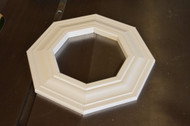Clean Cuts = Less Sanding
09 21 2014
In an ideal world, sanding is a finishing task only. A real drywall pro can 'mud' the screws and joints on a wall so that it requires just a quick sand before painting. I typically have to sand and re-apply the joint compound several times before I am ready for paint. I know fiberglass crews that can do much the same in their medium. And frankly, as a woodworker, I can do the same.

Nearly anyone can cut two pieces of wood and join them together, but to cut them so that the joint is clean, strong and requires little to no filling and sanding requires attention to detail. Insuring that the saw is well tuned, with the blade set exactly parallel to the miter slot, and that the miter gage is set accurately all contribute to being able to create tight fitting, clean joints that require virtually no clean up after gluing.

Here I am cutting a series of 22 1/2 degree angles to create an octagon as a test of the accuracy of my miter gage. The octagon will clearly show even a small deviation in the angle of the cuts since any error is multiplied by the number of cuts. Once the parts are dry fit together, it becomes very apparent that the cuts are very clean and fit together extremely well. In this case, any sanding of the joints would likely harm the fit rather than help.

Any tool in your shop will cut cleaner and with greater accuracy when properly maintained and tuned. And never forget the blade or bit you are cutting with! the blade is where 'the rubber meets the road' and just like car tires, using the right blade for the material and cut will greatly enhance your fit and finish. Yes, we sell sanding supplies, and yes we want to sell more of them to you. We just figure that if you work more efficiently, you will have more need of, and cash for, more sanding supplies!
Share your tips and tricks for reducing sanding around your workplace. You can comment here on the blog, on our Facebook page, or via Twitter. -2Sand.com

